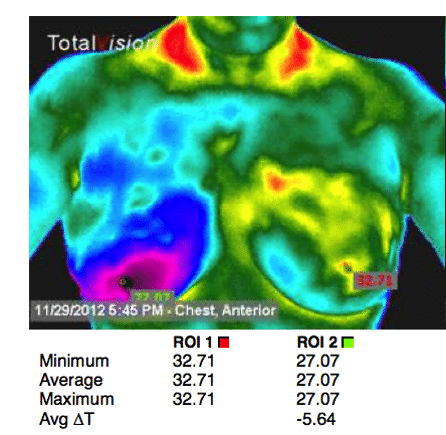
Thermography Image of a Suspicious Breast Lesion
Recently I have had several patients who had a screening mammography done and were told their breasts were dense. What does that mean exactly? Does this mean they have an increased risk of breast cancer?
What Causes Dense Breasts?
Breast tissue is made up of fat, glandular, and fibrous connective tissue. Fat is less dense and appears dark on a mammogram, while glandular and connective tissues appear light. Some women have denser breast tissue than others. This can be due to estrogen dominance due to high estrogen levels in younger women, birth control pills, weight gain in adulthood, alcohol consumption, red meat, sugar, and caffeine consumption. Increased breast density in older women appears to be a linked to exposure to xenoestrogens from the 3 P’s (pesticides, plastics, and petroleum). These estrogens get stored by the body in the fat tissue if they are not successfully detoxified by the liver.
40-50 % of women have dense breast tissue. This is very common, however the risk of breast cancer is 4 to 5 times greater in women who have increased density in more than 75% of their breast tissue than in women with little or no density of the breast. One third of all breast cancers are found in women who have breast density in over 50% of their breast.
Mammography is Not Accurate in Women With Dense Breasts
Mammography is not very accurate in women with dense breasts. As we said before, dense breast looks white on a mammogram. Breast cancer or precancerous tissue, also looks white because it is often contains calcification. Looking for breast cancer in dense breast tissue is like looking at a snowball in a snowstorm!
In a study of 2D mammography by the Journal of American Medical Association, mammography misses about 50 % of tumors in women with dense breasts. This is not a good track record! And false positive mammography readings cause women to have to undergo unnecessary biopsies, which are negative 80% of the time according to the National Institute of Health because imammography cannot tell the difference between cancer and non cancer in dense breast tissue.
Compare this to the sensitivity of ultrasound which is 74% and thermography, which is 90% and they cause no radiation.
Thermography Uses Heat and can identify tumors in dense breasts
Thermography can identify tumors in dense breasts because it is it is detecting heat, not anatomy. And thermography can identify lesions years before they are detectable as a spot on a mammography or as a lump that you can palpate. This gives you a chance to reverse the lesion before it becomes a cancer by working on a prevention program.
Reference: Thermography – The Fibrocystic & Dense Breast , A Radiation–Free Survival Guide for Happy, Health Breasts, by Patricia Bowden-Luccardi CTT

